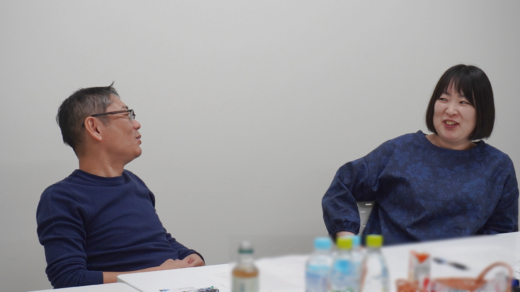Molecular Discoveries and Family Bonds at Kanazawa NanoLSI
At the heart of cutting-edge molecular imaging research at Kanazawa University’s Nano Life Science Institute (NanoLSI) is a unique scientific partnership: Assistant Professors Ayumi Sumino and Takashi Sumikama. Their collaboration bridges experimental and theoretical research, advancing the understanding of molecular dynamics using high-speed atomic force microscopy (HS-AFM) and molecular simulations.
Blending Expertise: A Scientific Partnership
 Dr. Sumino and Dr. Sumikama are pioneers in exploring sodium channels and ion transport mechanisms. Their complementary expertise—Sumino as an HS-AFM experimentalist and Sumikama as a molecular simulation theorist—enables them to tackle complex scientific challenges. For example, Sumino’s HS-AFM work visualized voltage-sensing domains (VSDs) forming dimers, while Sumikama’s simulations confirmed these structures and assessed their stability. Their synergistic approach has uncovered novel insights into how sodium channels function, potentially informing future drug development.
Dr. Sumino and Dr. Sumikama are pioneers in exploring sodium channels and ion transport mechanisms. Their complementary expertise—Sumino as an HS-AFM experimentalist and Sumikama as a molecular simulation theorist—enables them to tackle complex scientific challenges. For example, Sumino’s HS-AFM work visualized voltage-sensing domains (VSDs) forming dimers, while Sumikama’s simulations confirmed these structures and assessed their stability. Their synergistic approach has uncovered novel insights into how sodium channels function, potentially informing future drug development.
“Our scientific discussions can be quite intense,” Sumino says. “Sometimes they even turn into debates, but this helps push our research further.” Sumikama adds that, “Because we are a married couple, we can delve into tough questions that may be difficult to address with other collaborators.”
Scientific Milestones and Future Goals
“The theoretical speed of HS-AFM can reach the microsecond range, but we need new analytical techniques to make this feasible,” explains Sumikama. They are also investigating brain receptors and molecular structure fluctuations, laying the groundwork for potential therapeutic applications in neurology and sensory research.
Balancing Science and Family
Managing dual careers while raising two young children presents challenges. “We don’t usually talk about research at home—though sometimes we do, despite our best efforts,” Sumino admits with a laugh. The couple navigates family life through shared responsibilities, from childcare drop-offs to taking turns staying home when the children are sick.
“Our daughter doesn’t fall asleep easily,” Sumikama shares, acknowledging the added challenge of sleepless nights. “We’ve had to become very efficient with our time, both at work and at home.” The couple has learned to adapt their schedules and divide duties, ensuring both professional and family obligations are met.
Despite their busy lives, Sumino finds time for creative hobbies like sewing clothes for their children. “I do it late at night when the kids are asleep. It’s a way for me to reset, even though it’s tiring,” she says. Meanwhile, Sumikama enjoys cooking and classical music, occasionally blending these passions into family life.
NanoLSI has provided some family-friendly support, such as diaper-changing stations, though the couple expressed hopes for on-campus childcare to ease work-life balance. “Our biggest concern is job stability,” Sumikama notes, referring to his fixed-term position compared to Sumino’s longer-term permanent role at the NanoLSI.
Encouraging Women in Science
As a woman in a male-dominated field, Sumino reflects on the cultural barriers women face in Japan. “There are still stereotypes that women should avoid science,” she notes. Both agreed that changing societal perceptions and making science “cool” could encourage more girls to pursue STEM careers.
“When I was in high school, teachers often encouraged boys to choose science while steering girls toward arts,” Sumino recalls. Sumikama added, “It’s also about showing girls that science isn’t ‘geeky’ or ‘weird’—it’s exciting and full of discovery.”
Looking Ahead
Sumino and Sumikama’s shared journey continues to inspire. From revealing molecular secrets to navigating the complexities of family life, their story highlights how intellectual partnership and mutual support can advance both science and personal fulfillment. Their legacy may well be remembered not just for their scientific contributions but for showing how collaboration in life can lead to groundbreaking discoveries in the lab.
Further information
Feature article
Probing ion channels: High-Speed AFM for elucidating the dynamics of biological membranes
https://nanolsi.kanazawa-u.ac.jp/en/about/diversity/ayumi-sumino/
Related Research papers
- Sumino, T. Sumikama, Y. Zhao, H. Flechsig, K. Umeda, N. Kodera, H. Konno, M. Hattori, and M. Shibata, “High-Speed Atomic Force Microscopy Reveals Fluctuations and Dimer Splitting of the N-Terminal Domain of GluA2 Ionotropic Glutamate Receptor-Auxiliary Subunit Complex”, ACS Nano, 18, 25018-25035, (2024).
https://doi.org/10.1021/acsnano.4c06295 - Sumino, T. Sumikama, M. Shibata, and K. Irie, “Voltage sensors of a Na+ channel dissociate from the pore domain and form inter-channel dimers in the resting state”, Nat. Commun.14, 7835, (2023).
https://doi.org/10.1038/s41467-023-43347-3 - Tsujioka, A, Sumino, Y. Nagasawa, T. Sumikama, H. Flechsig, L. Puppulin, T. Tomita, Y. Baba, T. Kakuta, T. Ogoshi, K. Umeda, N. Kodera, H. Murakoshi, and M. Shibata, “Imaging single CaMKII holoenzymes at work by high-speed atomic force microscopy”, Sci. Adv.9, eadh1069, (2023).
https://doi.org/10.1126/sciadv.adh1069
Posted: January, 2025

